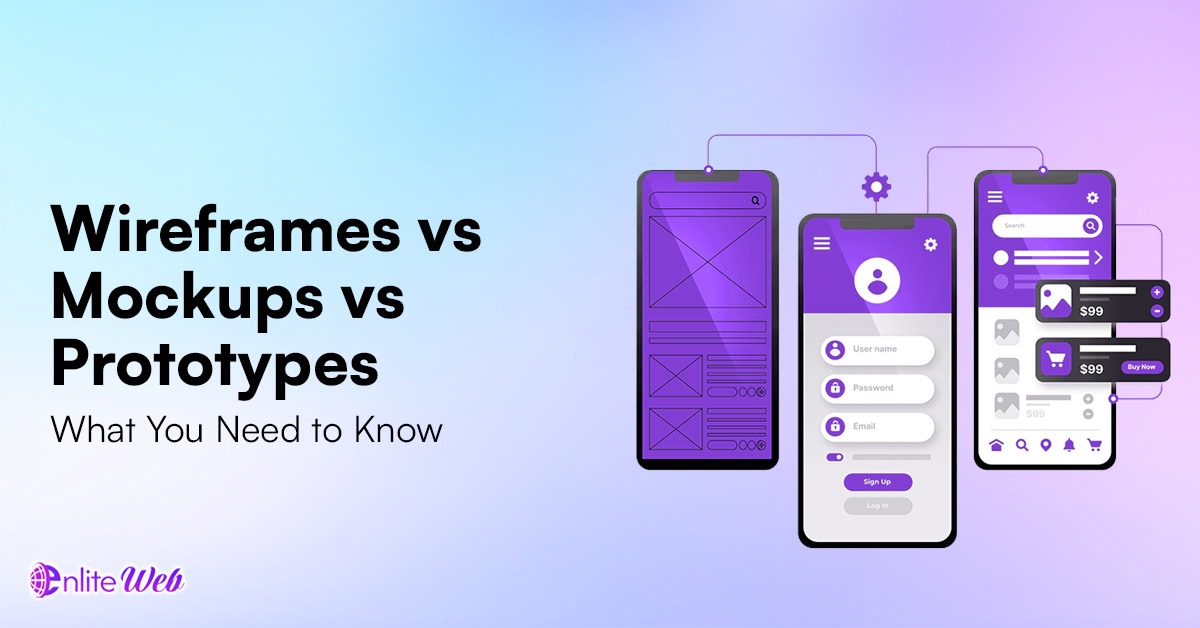Have you ever attempted to explain to a friend the great idea of an app, and they face you with a blank expression showing utter bewilderment? You have it as clear as day in your mind, but it is hard to put that image into words. This is one of the barriers of the design and development world. Thou hast need a means to demonstrate, not to relate. This is where wireframes, mockups, and prototypes are involved.
Although these two terms are used interchangeably, they are actually different phases in the design process, each having its purpose and level of detail. The distinction is important to any person dealing with the development of a digital product, whether it is a startup founder or an established project manager. The guide will deconstruct and demystify the wireframes versus mockups versus prototypes debate, and explain what each one of them represents, when a particular one should be used, and how they relate to each other to transform a mere notion into a fully-developed product. We will look into their respective functions, and we will assist you in selecting the appropriate tool for the appropriate job.
What is a Wireframe? The Blueprint of Your Idea
Imagine a wireframe as the bones of your website or app. It is a low-resolution, bare bones visual guide that is totally structured and functional oriented. Forget about colors, fonts, or pictures; wireframes are all about the bare bones. They specify where crucial elements will be by using approximate shapes, lines, and empty text (such as lorem ipsum).
The main purpose of a wireframe is to plot the user flow and information architecture. It provides solutions to some of the basic questions, such as:
- What is going to be on this page?
- Where is the navigation going to be?
- What is the way a user can move around between screens A and B?
So, what is the information hierarchy of every page?
Wireframes are ideal to begin with since they are easy and fast to make. You could draw them up on a whiteboard, on a piece of paper, or with digital tools such as Balsamiq or Sketch. Their imprecision is on purpose. It compels all the team members, designers, developers, and stakeholders to always concentrate on the core structure and user experience without being distracted by a color they do not like. This is where big-picture thinking and quick iteration happen.
- The important features of a Wireframe include:
- Low-fidelity: simple, black and white designs.
- Focus on Structure: Concentrates on the layout, the position of the content, and functionality.
- No Visual Design: Omnits colors, typography, and image.
Quick and Cheap: These are simple to construct and alter, thus they are suitable for generating brainstorming in the initial phases.
What is a Mockup? Adding Visual Life to the Structure
Have you ever attempted to explain to a friend the great idea of an app, and they face you with a blank expression showing utter bewilderment? You have it as clear as day in your mind, but it is hard to put that image into words. This is one of the barriers of the design and development world. Thou hast need a means to demonstrate, not to relate. This is where wireframes, mockups, and prototypes are involved.
Although these two terms are used interchangeably, they are actually different phases in the design process, each having its purpose and level of detail. The distinction is important to any person dealing with the development of a digital product, whether it is a startup founder or an established project manager. The guide will deconstruct and demystify the wireframes versus mockups versus prototypes debate, and explain what each one of them represents, when a particular one should be used, and how they relate to each other to transform a mere notion into a fully-developed product. We will look into their respective functions, and we will assist you in selecting the appropriate tool for the appropriate job.
What is a Wireframe? The Blueprint of Your Idea
Imagine a wireframe as the bones of your website or app. It is a low-resolution, bare bones visual guide that is totally structured and functionally oriented. Forget about colors, fonts, or pictures; wireframes are all about the bare bones. They specify where crucial elements will be by using approximate shapes, lines, and empty text (such as lorem ipsum).
The main purpose of a wireframe is to plot the user flow and information architecture. It provides solutions to some of the basic questions, such as:
- What is going to be on this page?
- Where is the navigation going to be?
- What is the way a user can move around between screens A and B?
So, what is the information hierarchy of every page?
- Wireframes are ideal to begin with since they are easy and fast to make. You could draw them up on a whiteboard, on a piece of paper, or with digital tools such as Balsamiq or Sketch. Their imprecision is on purpose. It compels all the team members, designers, developers, and stakeholders to always concentrate on the core structure and user experience without being distracted by a color they do not like. This is where big-picture thinking and quick iteration happen.
- The important features of a Wireframe include:
- Low-fidelity: simple, black and white designs.
- Focus on Structure: Concentrates on the layout, the position of the content, and functionality.
- No Visual Design: Omnits colors, typography, and image.
Quick and Cheap: These are simple to construct and alter, thus they are suitable for generating brainstorming in the initial phases.
What is a Prototype? Making Your Design Interactive
A prototype is whereby your design is eventually brought to life. It is a fidelity interactive prototype of the finished product. The mockup displays the appearance of the product, whereas a prototype displays the behavior of how the product would feel. The user is able to press some buttons, move between screens, and manipulate other components of the UI, and it is very similar to the real user experience.
The prototypes play a vital role in usability testing. You can collect priceless feedback about the user flow, navigation, and generally how intuitive the design is by presenting a clickable prototype to actual users. Is there a point at which the user becomes stuck? Are the buttons easy to find? Does the workflow make sense? The time spent answering these questions prior to writing a line of code can save thousands of dollars and hours of rework.
Examples of prototypes include basic click-through prototypes created with tools such as InVision or Figma, or more advanced, code-based prototypes with animations, transitions, and micro-interactions. The idea is not to develop the entire product, but to develop a realistic enough simulation that will confirm the design and user experience. A definite decision in the wireframes vs mockups vs prototypes list is critical for good testing.
The following are the important features of a prototype:
- High-fidelity: An interactive model of the product which is realistic.
- User experience Simulation User interaction and navigation.
- Interactive: Users can tap, click, and interact with the elements of design.
- Best Usability Testing: Provides the opportunity to detect and eliminate UX problems before development.
Wireframes vs Mockups vs Prototypes: The Key Differences
It is one thing to know the individual definitions, but to observe where they directly compare, their respective roles become even more obvious. We should divide the main distinctions between the wireframes vs mockups, vs prototypes debate.
| Aspect | Wireframe | Mockup | Prototype |
| Purpose | Defines structure and hierarchy | Defines visual identity | Simulates user interaction |
| Fidelity | Low | Mid-to-high | High |
| Interactivity | None | None | High |
| Focus | Functionality and user flow | Look and feel | Usability and user experience |
| Tools | Pen & paper, Balsamiq, Whimsical | Figma, Sketch, Adobe Photoshop | Figma, Adobe XD, InVision, Axure RP |
| Time to Create | Hours | Days | Days to weeks |
| Cost to Create | Low | Moderate | Moderate to high |
| Who Uses It? | UX designers, project managers | UI designers, stakeholders, and clients | UX researchers, test users, developers |
Finally, these three deliverables are not competitors. These are the consecutive stages of an integrated design. A wireframe is used to ensure that the structure is achieved, and then a mockup is done to ensure that the appearance is achieved, and finally, a prototype is done to test the experience.
When Should You Use Each One?
Keep in mind what they are, and you are halfway. The ability to know when they are to be used is what will make your design process efficient and effective.
Use a Wireframe When:
- You are at the first phase of ideation.
- You will have to sketch out the basic structure and the user experience.
- You desire conformity in functionality without the visuals.
- You must do layout and content hierarchy through trial and error.
Use a Mockup When:
- You possess a wireframe that has been approved, and you are now willing to establish the visual style.
- You have to introduce the look and feel to the stakeholders or the clients and seek their approval.
- You are making choices on color, typography, and images.
- You require a graphical guide for the development team.
- Use a Prototype When:
- You already have a finished mockup and have to test your user experience.
- You wish us to do real user usability testing prior to development.
- You have to show multifaceted interactions, animations, or user flows.
- You desire to achieve ultimate stakeholder buy-in using an interactive model.
The wireframes vs mockups vs prototypes debate is not about choosing one of these instead of the other; it is the realization of their role within the product development lifecycle. Delays are usually short-circuited with the thought that time will be saved, but the result can be disastrous in the future. As an example, it can be an elegant but structurally defective product when jumping directly to a high-fidelity prototype without wireframing.
Bringing It All Together: A Cohesive Workflow
The process of raising the fidelity of a simple idea up to a fully-realized digital product is a fidelity incremental process. Every step is based on the one before it, and you are making smart and tested decisions in between.
Begin with the Wireframe: Think it through. Look at the location of what, and the way the user navigates through the product. Test, revise, and do not proceed until the blueprint is concrete.
Flesh it with a Mockup: Use the visual layer. It is here that your brand personality comes out. Test colors, fonts, and pictures till the design is comfortable. Collect feedback, in particular, on the aesthetics.
Bring it to Life with a Prototype: Add Interactivity. Connect the screens with each other, make elements clickable, and imitate the user experience. Usability Test it with users to identify and correct any usability errors.
In this order, you will be sure you are creating the correct product and creating the product correctly. The stages enable you to receive certain feedback, mitigate risk, and prevent the necessity to make changes at the development stage at a rather high cost. The wireframes vs mockups vs prototypes model is a guide towards transforming abstract concepts into real, practical experiences.
The next time you get a brilliant idea, then you do not simply attempt to explain. Draw a wireframe, construct it into a mockup, and test it as a prototype. By being able to demonstrate your vision, you will be able to receive more feedback, unify your team, and begin your project with success right away.



